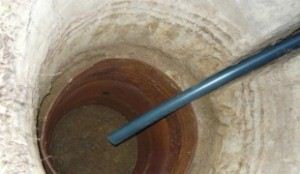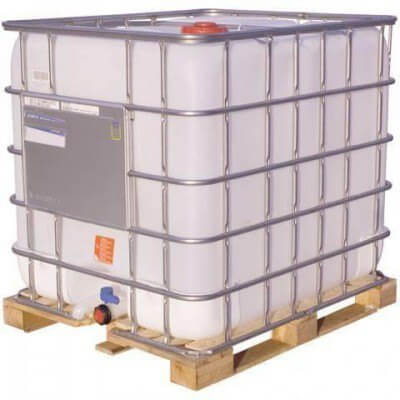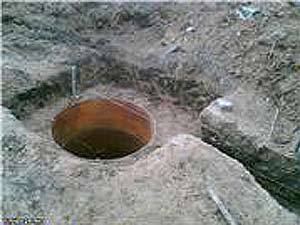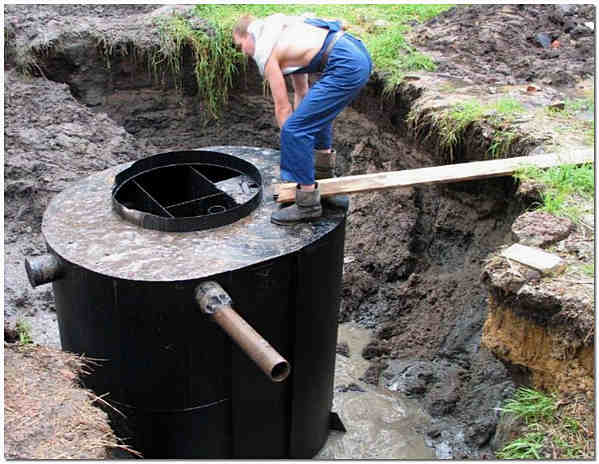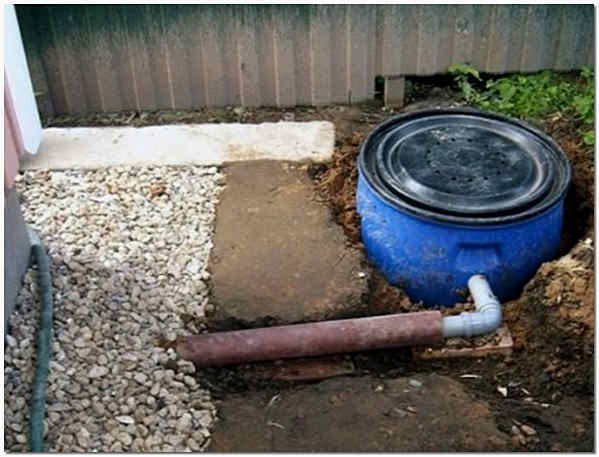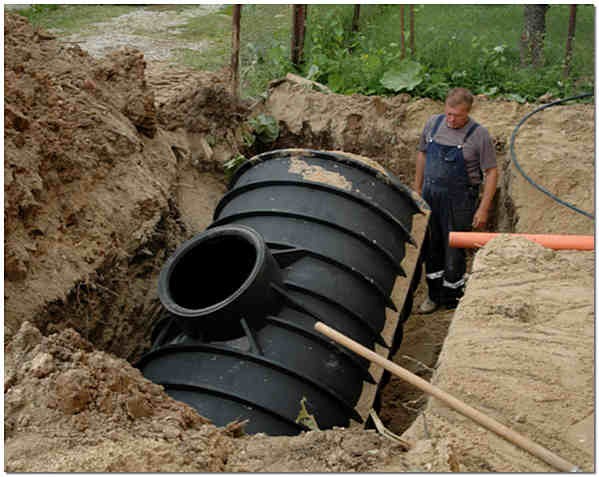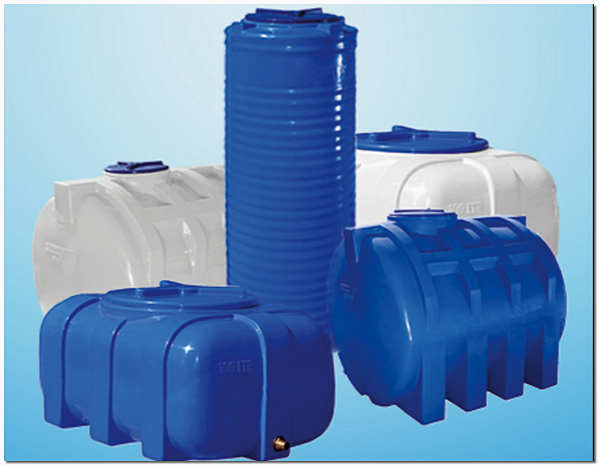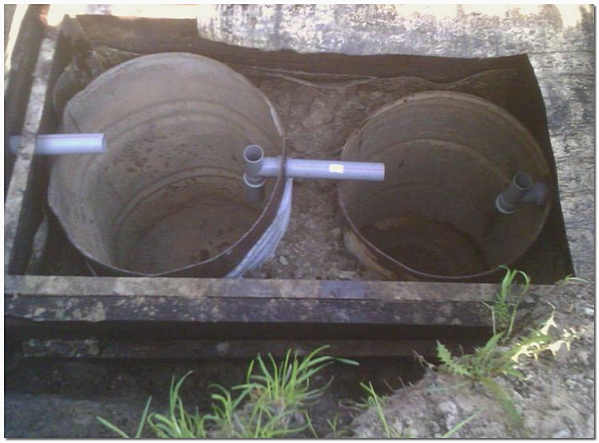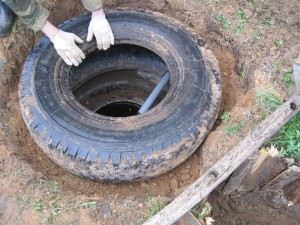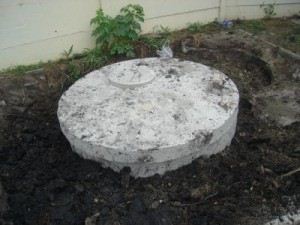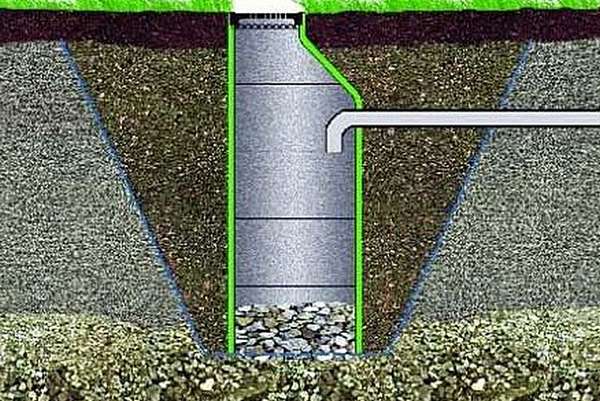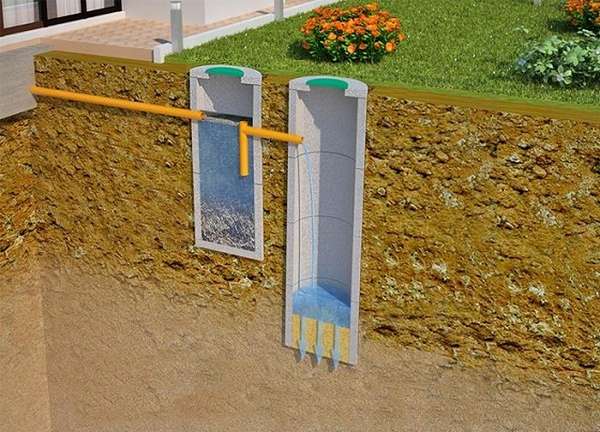Laying a drain pipe from a bath
The exit of the sewer pipe into the pit
The arrangement of drain pits begins with the laying of a drain pipe, which will lead from the bath to the treatment plant.
- The construction of the drain pipe begins with the construction of the foundation for the bath.
- When laying the pipe, turns, bends and joints are not allowed. If this requirement is not observed, there is a risk of blockages.
- After installing the drain pipe, the floor in the bath is filled with a concrete screed, while the floor is made with a slope towards the pipe. After the screed dries, tiles or other moisture-resistant finishing material can be laid on the floor.
- The drain hole of the pipe should be protected with a grate to prevent debris from entering the pipeline.
Advice! Insulation of the floor in the bath, as a rule, is not done. Since a properly constructed floor warms up quickly when the stove is fired and does not let in the outside cold. The drain pipe, laid with the necessary slope, also does not require insulation.
Methods for arranging drain pits for baths in personal plots
As the popular proverb says: "In the kulak economy, even an oxtail is a rope." And our compatriots use things for summer cottages that are completely useless at first glance. An example of this is a drain hole made from old tires. It is best to use tires from tractors and heavy trucks, as they have a large radius and are quite rigid.
The side walls of the tires are cut off using construction power tools (jigsaw, grinder). It is also necessary to cut a hole in order to insert a pipe there, and organize a drain. A kind of pyramid is built from the prepared tires to the top of the pit, and a gravel-sand cushion is laid below. Instead of a concrete slab and screed, such pits are covered with a piece of sheet metal.
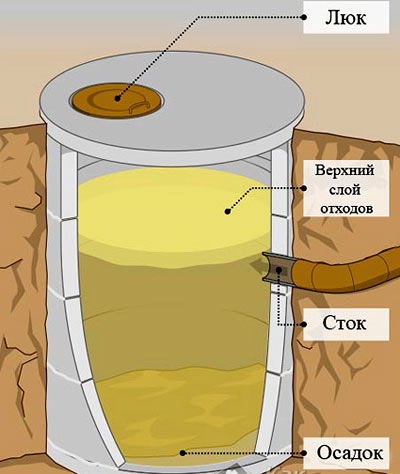
In order to disguise an unsightly drain hole, you can sprinkle it with earth and plant flowers there. In addition to the visual effect, this can achieve additional insulation of the tire pit in the winter.
In order to organize a drain from the bath, in addition to the tire pit, the following method is very often used. Pieces of slate are placed perpendicularly in the drain pit, forming air chambers for sewage to pass through them. The drain from the pipe should be at the very top of this structure. The walls of the pit are also reinforced with slate. This method of sewerage arrangement is acceptable for areas with low ground loads, if cars drive in this place, its use is unacceptable.
There is a way to build a drain pit from a metal barrel. Barrels with a volume of 200 liters are used as a container. In the tank, it is necessary to make holes for draining in a checkerboard pattern.
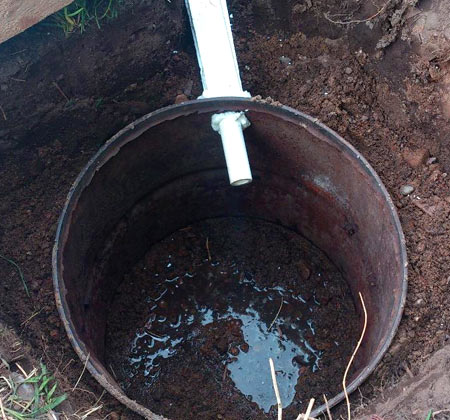
To cut the barrel, you should have a grinder on hand. At the bottom of the barrel, you need to place a pipe to which the drain will be connected. The joint should be treated with a sealant.
Barrels are wrapped with geotextile for protection. To fasten geotextiles, you can use adhesive tape or rope. It should be noted that the dimensions of the pit must exceed the dimensions of the metal barrel located there.
Whatever method of building a sewer for a bath is provided, we can conclude that it is absolutely necessary. Many people prefer to abandon the sewerage system, explaining that due to the infrequent use of the steam room, this will lead to completely unnecessary expenses.
In the summer, runoff goes by gravity into the soil, and in winter its amount is even less. These conclusions are completely wrong. In the summertime, water accumulating under the bathhouse causes the bathhouse to start to rot.
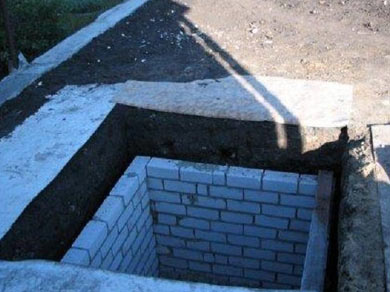
In winter, freezing sewage causes the foundation to freeze. All this will subsequently lead to the destruction of the building and cause even greater expenses. As we can see, in order to make a sewer in the bath with your own hands, you can use improvised means and thereby get by with “little blood”. Therefore, it is best to protect yourself from future troubles and install a drain for a bath.
Brick drain construction
A cesspool made of bricks is the oldest version of the arrangement of sewer walls. It can be sealed or with an open bottom. To facilitate construction, it is required to prepare a pit with even walls in order to lay bricks close to them. This will greatly speed up the work, especially if there is not enough experience in this area. A home cesspool made of brick is placed on a cement mortar. It is impossible to use light sand masonry, because in conditions of constant humidity, a collapse will be inevitable.
Masonry is done in half a brick in a circle. Thus, the corners hold each other tightly. With this method, additional modernization is possible to improve the tightness. To do this, you need to plaster the walls and fill the bottom. You can use old brick, mined from destroyed buildings. This construction method is the longest. A brick cesspool is one of the most reliable and if you use a strong mortar, then its destruction will not happen soon. One has only to prepare a hole for the inlet pipe in advance, since it will be difficult to break through the wall later.
Criterias of choice
Choose the type of well according to the following criteria:
- Dimensions. For many owners, the weight, length and section of the mine matters.
- Technical characteristics of the material: durability, resistance to corrosion and aggressive environments, fracture and tensile strength.
- Price. For many masters, this parameter is important, since the installation of an extended drainage system can cost a pretty penny.
Often, in order to save money, the owners of summer cottages decide to install a drainage system with their own hands. a well made of tires or polymer containers. But the tightness of such a reservoir remains in question, since it is difficult to achieve the absolute integrity of the mine. Over time, it will still allow groundwater to pass through, and the tires will deform under the influence of heaving soil.
What to do before construction starts
The mouth of the pit filled with soil
Everyone knows that the construction of any object or communication must begin with design. The construction of a treatment plant for a bath will not be an exception.
GWL assessment
First of all, you need to find out at what level the underground soil waters lie. If this level is high enough, then the construction of a traditional drain pit will have to be abandoned, since it will be filled with soil water.
How can you determine at what distance from the surface the groundwater occurs? As a rule, to obtain this information, it is necessary to carry out a hydrogeological study, including the drilling of ores. However, a preliminary assessment of the situation can also be made using ancient folk methods:
- If there are wells nearby, then by the level of water in them, one can draw a conclusion about the GWL.
- Another sign is that with a high GWL, many plants grow on the site that need moisture in large quantities. For example, horsetail, coltsfoot, reed, sedge, etc.
Brick drain hole
Determining the volume of chambers and other nuances of construction
The volume of the receiving chambers depends on how the bath is designed for the person - the drain pit should be the larger, the more people will use the washing room.
With insufficient volume of the pit, wastewater simply does not fit in it and will flow over the edge. Also, the quality of the soil on the site should be assessed, it depends on whether it will be necessary to strengthen the edges of the pit.
The location of the treatment tank should be determined in advance. As a rule, it is recommended to place the pit at a distance of 2-2.5 meters from the bath. Otherwise, it will be difficult to build a pipeline with the required slope.
Cesspool options
The choice of the buyer is given two types of barrels - iron and polymer.
Pros and cons of an iron barrel
Metal barrels have high strength, impressive weight. It should be borne in mind that the metal does not tolerate constant moisture. Without sufficient treatment, corrosion will eat away at a steel pit sump in 3-4 years. For its installation, it is necessary to attract lifting equipment.
To avoid metal decay (corrosion), before installing an iron barrel for sewage, it is worth performing a number of waterproofing works:
- For outdoor use, polymer coating waterproofing can be used. It is good because, due to its plasticity, it can be applied to any surface shape.
- The inner surface should be treated with liquid application materials. In some cases, summer residents use nitro paint, but this method is inferior to processing with factory materials.
Among other waterproofing methods, domestic manufacturers offer injection materials. These are two or three-component compositions based on polyurethane resin. Their advantages include good adhesion (adhesion) of materials to the surface of the barrel, good water-repellent characteristics and strength of the material itself. By cons - the high toxicity of the components.
In order to treat the barrel with an elastic injection material, additional protection must be taken into account.
For more competent handling of resins, it is desirable to have special skills in handling such insulation.
Advantages of a polymer barrel
Plastic barrels for drain pits are easy to operate. They are already equipped with an air vent, a convenient manhole cover, holes for mounting PVC sewer pipes and much more. In addition, unlike iron ones, they are light in weight and do not require the involvement of additional equipment during installation.
The material of the barrel is not exposed to external influence of acids and alkalis of soil water, which solves the problem of its replacement. A huge number of shapes and volumes by displacement allows you to choose the PVC sewer container you need for your needs. Its inner surface is resistant to aggressive environments.
When laying the project of a sealed drain pit, it is worth considering that a closed system is more profitable, since wastewater does not enter the ground and does not cause environmental pollution.
The accumulated sewage can create underground mudflow cushions and destroy the foundations of nearby buildings. In this case, the only disadvantage of a closed sewer pit will be the constant pumping of slurry. But if you take into account all the pluses, it is easy to come to terms with this fact.
Airtight pit device
The whole system looks simple and easy to install. The sewerage wiring around the house is led into a barrel, dug no closer than 5-6 m. All drains are collected in the pit, it is very convenient to pump out with a sewer machine, especially if the distance from the fence is no more than 2 m.
You need to dig the barrel no deeper than 7 m. Otherwise, the pumping hose will not be able to pick up all the slurry and will only collect liquid from the surface. When calculating the location of the tank, it is necessary to take into account the features of the terrain. If the house is in a lowland, there is a high probability that after heavy rainfall, water will accumulate in large quantities. It is recommended to use large barrels, since light containers can be forced to the surface by heaving soil and soil water from the pit.
If the family has more than two people, it is worth thinking about organizing an overflow type drain pit. The design consists of two successively located barrels.The containers are located one slightly higher than the other. The connection is provided by a built-in additional pipe. The liquid is pumped out individually from each barrel.
In both options, the barrel must be installed, providing easy access to the vacuum truck. When sealing the barrel opening, it is necessary to leave a Ø100 mm ventilation hole for the vent pipe. During the decomposition of organic waste (faecal matter) of sewage, a large amount of methane is formed. To remove it effectively, the pipe must rise half a meter from the soil level. If there is no gas outlet, the barrel will explode.
The blind area around the barrel lid remains a controversial issue. Some sources do not recommend pouring concrete around the hole. Since when the soil subsides, the concrete circle can begin to put pressure on the upper part of the container and thereby damage its tightness.
Drainage pit construction
Tire cesspool example
If the soil on the site is strong and, at the same time, has excellent filtering properties, then the construction of the pit consists in digging a pit and constructing a drainage layer of crushed stone or gravel.
However, such ideal conditions are extremely rare. As a rule, well-draining soils tend to crumble, so when building a pit, it is necessary to provide for the strengthening of its walls.
Options for materials that can be used to lay out the walls of the pit:
- The brick is moisture resistant (ceramic).
- Slate sheets.
- Rings from reinforced concrete are well.
An example of a finished cesspool
You can also use improvised materials:
- Old tires with a rim cut off on one side.
- Barrels made of plastic or metal. The bottom of such barrels is removed, and holes are made in their lower part for the passage of water.
Installation steps
- The first and most time-consuming stage of construction is the preparation of a pit for a pit and a trench for laying a pipe. The excavated soil should either be scattered over the site (if it is high-quality soil), or taken out of it.
- During the construction of a brick tank, the walls are laid half a brick thick - this saves material. In the rows of brickwork, five-centimeter gaps are made to drain the liquid.
Advice! Masonry can be made not only from brick, but also from natural stone.
- When constructing a tank from concrete well rings, perforated products should be selected. If it was not possible to buy them, then you will have to form holes yourself with a puncher.
- After completing the process of strengthening the walls of the pit, the formation of a drainage layer at the bottom should begin. To do this, sand and gravel are poured into the pit, the layer thickness is at least 20 cm.
Advice! If there is no crushed stone, construction waste - broken brick or concrete can be used to form a drainage layer.
- Strengthening the walls of the pit is completed at a distance of 40 cm from the surface of the earth. At this level, an overlap should be arranged - lay a finished reinforced concrete slab or pour the mortar along the formwork built in advance.
- An opening should be provided in the ceiling, which will be used to control the filling of the pit with drains, and, if necessary, to pump out water. The hole is closed with a secure hatch. After that, the drain pit in the bath is ready.
When building a bath, a system for discharging used water should be provided. An inexpensive and practical option for waste disposal is a drain pit for a bath. You can build this structure on your own, without involving teams of builders, since there is nothing complicated in its design.
http://kanalizaciyam.ru
The main types of drain pits
- 1 Main types of drain pits
- 2 Materials for arranging a drain pit for a bath
- 2.1 Drainage pit from barrels
- 2.2 Brick drain pit
- 2.3 Drainage pit made of concrete rings
- 2.4 Pit from old car tires
- 3 How to independently equip a drain pit for a bath
- 3.1 Examination of the soil at the site of the planned drain pit
- 3.2 Some recommendations for arranging a drain pit
- 3.3 Arrangement of a drain drainage pit - step by step
- 3.3.1 Conventional drainage pit
- 3.3.2 Pit according to the principle of a two-chamber septic tank with an outlet to the filtration field
- 3.3.3 Video: How to make a drain for a bath yourself, at minimal cost.
The arrangement of any drain pit is a rather laborious process, since the pit will most likely have to be dug manually. At the same time, such a hydraulic structure does not differ in the complexity of the design, so any owner of the site can build and equip it on their own, without even involving assistants, of course, if there is enough strength for earthmoving.
Drainage pits can be divided into three main types - a sealed container, a pit with drainage capacity, and a septic tank consisting of several chambers.
To begin with, let's figure out what each of the varieties is in principle.
A sealed drain pit is most often equipped at construction sites with shallow ground aquifers. It is often called a cesspool, that is, requiring periodic emptying of the collected volumes of dirty water.
For its construction, a pit is dug into which a container with a sufficiently large volume is installed. This is where wastewater will be collected. As the tank fills up to a certain critical level, the waste is pumped out by a sewage truck.
In the presence of a cesspool completely isolated from the external environment, it will be necessary to use the services of sewage equipment very often
This option is environmentally friendly, since no contaminants and chemical cleaning solutions enter the soil and groundwater, which can adversely affect the condition of the fertile soil on the site, as well as have a negative impact on high ground aquifers. However, this option is not convenient and cost-effective, since you will have to constantly monitor the filling level of the tank and often call specialized vehicles, and such services are not cheap.
A hermetically closed bottom is not created in the drainage drain pit. It is used as a bulk layer of filter building material - most often crushed stone or gravel is chosen for this purpose.
The bottom of the drainage pit is covered with a layer of filter material - crushed stone or gravel
In addition, holes are often made in the walls of the drainage pit at a certain height through which water will be absorbed into the soil. This option is great for a bath and is perhaps the easiest to build, however, if the characteristics of the soil on the site allow it.
A septic tank is a whole system consisting of two or more chambers with different purposes.
In any of the options, the first chamber most often has a sealed design and serves to collect, primary filter and treat waste - solid components settle to the bottom, and liquid ones are clarified, undergo a biological treatment cycle due to the action of aerobic microorganisms. This container is connected to the second chamber with a special overflow pipe - clarified liquid waste flows into the next compartment, which is already organized according to the principle of a drainage well. Water passes through the drainage, is cleaned and absorbed into the soil.
Approximate scheme of the device of the simplest septic tank
If a septic tank of three tanks is planned, then the third chamber is made drainage. The second serves for the final settling of suspensions, deeper water purification through the action of anaerobic microorganisms. And from here comes the overflow of the purified liquid into the drainage well.
A septic tank is most often equipped when it is supposed to collect the entire considerable amount of liquid waste from both a residential building and a bathhouse.
What is important to know about the design and rules of septic tank equipment?
A septic tank is already a rather complex engineering structure, the creation of which must obey certain rules. Often, homeowners prefer to install a prefabricated prefabricated system.
What are the rules for arranging such a treatment plant, and what to pay special attention to when choosing a septic tank - read in a special publication of our portal
